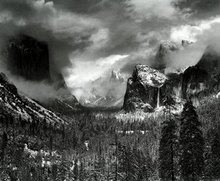
With the dawn of the digital age well upon us I thought I would share some thoughts regarding what I consider real landscape photography. I have often admired the majesty of the Ansel Adams photograph “Clearing Winter Storm”. This image to me is what landscape photography is all about, a majestic real life image caught in one exposure. Adams captured the moment in a decisive moment, to me that is the definition of a photograph, a single moment in time captured for posterity.
I look now at many digitally created images I see online or in my camera club and feel that thou the work is beautiful it is also a cheat. These photographs which are represented as a single moment in time are actually a collage of several exposures (moments)that creates the illusion of a decisive moment. A CAI (computer altered image) in my opinion is a cheat, and not a photograph but something else, they are works of Art but to call them photographs is a mistake, maybe they should be called collagagraphs.
Adams manipulated his work as well, he made the color real world b/w, he used filters and adjusted exposure and development (zone system) to change the tonal values. His work thou seems more honest in that he went back several times to get the photograph
“Clearing Winter Storm”, if you look at his book "Ansel Adams at 100" you can see how hard he worked to get the image, he repeatedly traveled back to the same place over the years and reshot the scene, until that one magical time where everything came together. He captured a real time event in a real single decisive moment, he did not need the cheat of photoshop to create this wonderful photograph. Adams had the discipline to go back over and over again, he worked and worked at it until he got it right.
I hope I can learn from his example. I need to follow in his footsteps and keep working until my images say what I want them to say. No Adobe cheats allowed, the photographs should be a single moment in time, if the image is not a success you should not fix your mistake in photoshop, you should work harder like Adams did to get the image the first time.

















































